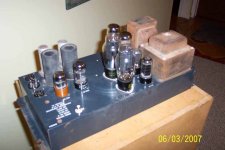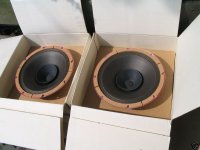Unfortunately the impedance transformation ratio is quite linear, if you connect an 80 ohm load and that reflects to 6600 ohms, connecting an 8 ohm speaker is going to reflect a 660 ohm load to the output tube plates which is far too low.
You'll either need to replace the transformers, get a 600 ohm pair of electrovoices or cobble up an auto transformer. Since there is no dc present on the output of the amplifier perhaps you could use a toroid power transformer to do the job. Something like a ~120V:60V with the windings wired in series as an auto transformer - or you could also just rewind one to do this. (winding tap ratio ideally about 2.16:1)
You'll either need to replace the transformers, get a 600 ohm pair of electrovoices or cobble up an auto transformer. Since there is no dc present on the output of the amplifier perhaps you could use a toroid power transformer to do the job. Something like a ~120V:60V with the windings wired in series as an auto transformer - or you could also just rewind one to do this. (winding tap ratio ideally about 2.16:1)
Tom Bavis said:Don't have time to do the math right now, but you can connect a low impedance speaker between two taps, say 80 and 125, for a reasonable ratio.
I think you're right. For anyone that wants to do the math them self, find the square of the difference between the square roots of the nominal tap 'values.'
Example: looking at a connection between the 250 and 166 ohm taps, [sqrt(250)-sqrt(166)]^2 = 8.6 ohms. 😎
-- Dave
Quote:
"Example: looking at a connection between the 250 and 166 ohm taps, [sqrt(250)-sqrt(166)]^2 = 8.6 ohms."
Dave are you saying that an 8.6 ohm speaker would be connected between the 250 & 166 ohm taps as if they were the 0 ohm & 8 ohm taps? If so then one would need to be grounded and the original 0 ohm tap would have to been disconnected if I am understanding you correctly?
Also this amp could be converted to be a 6AS7 PP amp since 660 ohms on 8 ohms works well. Thoughts? Certainly some reworking will be needed.
Finally, what about as a booster amp similar to the old western electric 845 theater amps that used a similar amp on the front end then connected to a pair of 845's in PP. I have this insane schematic and full book on the design maintenance and operation of such an amp. Than we have the potential of a Sakuma San style push pull preamp?
"Example: looking at a connection between the 250 and 166 ohm taps, [sqrt(250)-sqrt(166)]^2 = 8.6 ohms."
Dave are you saying that an 8.6 ohm speaker would be connected between the 250 & 166 ohm taps as if they were the 0 ohm & 8 ohm taps? If so then one would need to be grounded and the original 0 ohm tap would have to been disconnected if I am understanding you correctly?
Also this amp could be converted to be a 6AS7 PP amp since 660 ohms on 8 ohms works well. Thoughts? Certainly some reworking will be needed.
Finally, what about as a booster amp similar to the old western electric 845 theater amps that used a similar amp on the front end then connected to a pair of 845's in PP. I have this insane schematic and full book on the design maintenance and operation of such an amp. Than we have the potential of a Sakuma San style push pull preamp?
desperateaudio said:Dave are you saying that an 8.6 ohm speaker would be connected between the 250 & 166 ohm taps as if they were the 0 ohm & 8 ohm taps? If so then one would need to be grounded and the original 0 ohm tap would have to been disconnected if I am understanding you correctly?
That's exactly right. As Tom said, you shouldn't expect stellar results, but who knows until you try it.
Also this amp could be converted to be a 6AS7 PP amp since 660 ohms on 8 ohms works well. Thoughts? Certainly some reworking will be needed.
That's am interesting idea. Each tube would see 330 ohms. In my own experience with 6AS7 they sound better with a higher load. Something like 1k - 2k. But it's worth messing around with if you have the tubes and the time.
Finally, what about as a booster amp similar to the old western electric 845 theater amps that used a similar amp on the front end then connected to a pair of 845's in PP.
That's an even more interesting idea, at least as a use for the transformer if not for the entire amp as it is. If you use the entire secondary (0 and 500 ohm tap) you can think of it as a very beefy 3.6:1 stepdown interstage transformer. That tertiary feedback winding might be good for something too.
-- Dave
Yes, you could disconnect the existing common terminal from ground and connect a different one - but there's no law that one speaker terminal must be grounded - it can be connected to the pair you like, both floating. There MAY be significant voltage to ground, though, depending which taps you use, so plan A may be best... (30 Watts into 500 Ohms is 122 Volts of audio!)
Interesting circuit. Not what I'd call a GOOD circuit, but interesting. The input can be balanced or single-ended (that's where the paraphase is used...). The feedback around two gain stages and TWO transformers looks dangerous - don't remove the two .01 caps across the output transformer - it'll probably osilllate like mad without 'em. And yes, 1600V rating is required, ESPECIALLY if you're using it for guitar.
Interesting circuit. Not what I'd call a GOOD circuit, but interesting. The input can be balanced or single-ended (that's where the paraphase is used...). The feedback around two gain stages and TWO transformers looks dangerous - don't remove the two .01 caps across the output transformer - it'll probably osilllate like mad without 'em. And yes, 1600V rating is required, ESPECIALLY if you're using it for guitar.
Quote:
"That tertiary feedback winding might be good for something too."
Dave if you have time can you elaborate. Thanks
"That tertiary feedback winding might be good for something too."
Dave if you have time can you elaborate. Thanks
Duh, guess I should have worked out the fact that the ratio difference between the 125 and 80 winding would provide the right match, what it won't provide is relatively low dcr because of the size of the wire in the secondary winding.
The center-tapped feedback winding might be useful for cathode feedback, depending on ratio - it's probably too high in impedance (and resistance) to be used for an output. But cathode feedback will require more output from the driver... there are always tradeoffs.
One other thing that I do not think I mentioned. The OPT is a Chicago Standard Tranny LO-0129. No luck on ID for this OPT. Wondering if anyone has any idea.
70V is a standard for long lines to PA speakers. You may use 60W line transformer on the speaker end, they usually have taps for 4, 8, 16 Ohm speakers.
- Status
- Not open for further replies.
- Home
- Amplifiers
- Tubes / Valves
- Rauland Borg 6L6 amp Need Info

